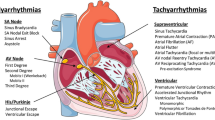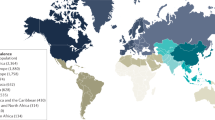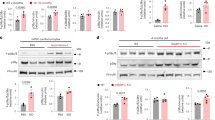Abstract
Cardiac arrhythmias are a leading cause of morbidity and mortality in many developed countries. Despite intensive investigation, the cellular mechanisms for most cardiac arrhythmias have not been clearly established. As a consequence, drug therapy for most forms of atrial and ventricular arrhythmias remains largely empirical and ineffective, leading to the increased use of nonpharmacologic treatments. Clearly, new approaches to the prevention of cardiac arrhythmias are needed. Here we review the current experimental basis for several promising antiarrhythmic strategies, with a focus on those targeted against atrial and ventricular fibrillation. Although none of these strategies is yet ready for clinical application, they provide a basis for cautious optimism that effective pharmacologic therapy for fatal cardiac rhythm disturbances could be forthcoming.
This is a preview of subscription content, access via your institution
Access options
Subscribe to this journal
Receive 12 print issues and online access
$209.00 per year
only $17.42 per issue
Buy this article
- Purchase on Springer Link
- Instant access to full article PDF
Prices may be subject to local taxes which are calculated during checkout
Similar content being viewed by others
References
Zipes DP et al. (1998) Sudden cardiac death. Circulation 98: 2334–2351
Echt DS et al. (1991) Mortality and morbidity in patients receiving encainide, flecainide or placebo: the cardiac arrhythmia suppression trial. N Engl J Med 324: 781–788
Waldo AL et al.; SWORD Investigators (1996) Effect of d-sotalol on mortality in patients with left ventricular dysfunction after recent and remote myocardial infarction. Lancet 348: 7–12
Winfree AT (1998) Evolving perspectives during 12 years of electrical turbulence. Chaos 8: 1–20
Jais P et al. (1997) A focal source of atrial fibrillation treated by discrete radiofrequency ablation. Circulation 95: 572–576
Antzelevitch C (2000) Electrical heterogeneity, cardiac arrhythmias, and the sodium channel. Circ Res 87: 964–965
Janse J and Wit AL (1989) Electrophysiological mechanisms of ventricular arrhythmias resulting from myocardial ischemia and infarction. Physiol Rev 69: 1049–1169
Karma A (1994) Electrical alternans and spiral wave breakup in cardiac tissue. Chaos 4: 461–472
Fox JJ et al. (2002) Spatiotemporal transition to conduction block in canine ventricle. Circ Res 90: 289–296
Weiss JN et al. (2002) Electrical restitution and cardiac fibrillation. J Cardiovasc Electrophysiol 13: 292–295
Pastore JM et al. (1999) Mechanism linking T-wave alternans to the genesis of cardiac fibrillation. Circ Res 99: 1385–1394
Riccio ML et al. (1999) Electrical restitution and spatiotemporal organization during ventricular fibrillation. Circ Res 84: 955–963
Garfinkel A et al. (2000) Preventing ventricular fibrillation by flattening cardiac restitution. Proc Natl Acad Sci USA 97: 6061–6066
Chen PS et al. (2003) A tale of two fibrillations. Circulation 108: 2298–2303
Fox JJ et al. (2002) Ionic mechanism of cardiac alternans. Am J Physiol Heart Circ Physiol 282: H516–H530
Salata JJ et al. (1998) A novel benzodiazepine that activates cardiac slow delayed rectifier K+ channels. Mol Pharmacol 53: 220–230
Heath BM and Terrar DA (2000) Protein kinase C enhances the rapidly activated delayed rectifier potassium current, IKr, through a reduction in C-type inactivation in guinea pig ventricular myocytes. J Physiol 522: 391–402
Marx SO et al. (2002) Requirement of a macromolecular signaling complex for β adrenergic receptor modulation of the KCNQ1-KCNE1 potassium channel. Science 295: 496–499
Hua F et al. (2004) Suppression of electrical alternans by overexpression of HERG in canine ventricular myocytes. Am J Physiol Heart Circ Physiol 286: H2342–H2351
Miake J et al. (2002) Biological pacemaker created by gene transfer. Nature 419: 132–133
Ennis IL et al. (2002) Dual gene therapy with SERCA1 and Kir2.1 abbreviates excitation without suppressing contractility. J Clin Invest 109: 393–400
Samie FH et al. (2001) Rectification of the background potassium current: a determinant of rotor dynamics in ventricular fibrillation. Circ Res 89: 1216–1223
Nishikawa M and Huang L (2001) Nonviral vectors in the new millennium: delivery barriers in gene transfer. Hum Gene Ther 12: 861–870
Sarmast F et al. (2003) Cholinergic atrial fibrillation: IK,ACh gradients determine unequal left/right atrial frequencies and rotor dynamics. Cardiovasc Res 59: 863–873
Nattel S (2002) New ideas about atrial fibrillation 50 years on. Nature 415: 219–226
Goldhaber JI et al. (2002) Cellular basis of action potential duration alternans: role of the L-type calcium current and intracellular calcium cycling. Circulation 106: 228–228
Wehrens XHT et al. (2004) Protection from cardiac arrhythmias through ryanodine receptor-stabilizing protein calstabin2. Science 304: 292–296
Anderson ME (2004) Calmodulin kinase and L-type calcium channels: a recipe for arrhythmias? Trends Cardiovasc Med 14: 152–161
Satoh T and Zipes DP (1996) Unequal atrial stretch in dogs increases dispersion of refractoriness conducive to developing atrial fibrillation. J Cardiovasc Electrophysiol 7: 833–842
Janse MJ et al. (2003) Mechanical effects on arrhythmogenesis: from pipette to patient. Prog Biophys Mol Biol 82: 187–195
Craelius W et al. (1988) Stretch activated ion channels in ventricular myocytes. Biosci Rep 8: 407–414
Clemo HF et al. (1999) Swelling-activated chloride current is persistently activated in ventricular myocytes from dogs with tachycardia-induced heart failure. Circ Res 84: 157–165
Niu W and Sachs F (2003) Dynamic properties of stretch-activated K+ channels in adult rat myocytes. Prog Biophys Mol Biol 82: 121–135
Isenberg G et al. (2003) Differential effects of stretch and compression on membrane currents and [Na+]c in ventricular myocytes. Prog Biophys Mol Biol 82: 43–56
Bode F et al. (2001) Tarantula peptide inhibits atrial fibrillation. Nature 409: 35–36
Chen RL et al. (2003) Stretch-induced regional mechanoelectric dispersion and arrhythmias in the right ventricle of anesthetized lambs. Am J Physiol Heart Circ Physiol 286: H1008–H1014
Komoro I and Yazaki Y (1993) Control of cardiac gene expression by mechanical stress. Ann Rev Physiol 55: 55–75
Allessie MA et al. (2002) Electrical, contractile and structural remodeling during atrial fibrillation. Cardiovasc Res 54: 230–246
Li D et al. (2001) Effects of angiotensin-converting enzyme inhibition on the development of the atrial fibrillation substrate in dogs with ventricular tachypacing induced congestive heart failure. Circulation 104: 2608–2614
Moreno AP (2004) Biophysical properties of homomeric and heteromultimeric channels formed by cardiac connexins. Cardiovasc Res 62: 276–286
Poelzing S et al. (2003) Heterogeneous connexin43 expression produces electrophysiological heterogeneities across the ventricular wall. Am J Physiol Heart Circ Physiol 286: H2001–H2009
Saffitz JE et al. (1999) Mechanisms of remodeling of gap junction distributions and the development of anatomic substrates of arrhythmias. Cardiovasc Res 42: 309–317
Kucera J et al. (2002) Localization of sodium channels in intercalated disks modulates cardiac conduction. Circ Res 91: 1176–1182
Poelzing S et al. (online 17 June 2004) Altered connexin43 expression produces arrhythmia substrate in heart failure [http://ajpheart.physiology.org/cgi/reprint/00346.2004v1] (accessed 15 September 2004)
Kostin S et al. (2004) Connexin 43 expression and distribution in compensated and decompensated cardiac hypertrophy in patients with aortic stenosis. Cardiovasc Res 62: 426–436
Yao J-A et al. (2003) Remodeling of gap junction channel function in epicardial border zone of healing canine infarcts. Circ Res 92: 437–443
Yamada KA et al. (2003) Up-regulation of connexin45 in heart failure. J Cardiovasc Electrophysiol 14: 1205–1212
Gaudesius G et al. (2003) Coupling of cardiac electrical activity over extended distances by fibroblasts of cardiac origin. Circ Res 93: 421–428
John SA et al. (1999) Connexin-43 hemichannels opened by metabolic inhibition. J Biol Chem 274: 236–240
Eloff BC et al. (2003) Pharmacological modulation of cardiac gap junctions to enhance cardiac conduction: evidence supporting a novel target for antiarrhythmic therapy. Circulation 108: 3157–3163
Acknowledgements
Grants given by: NIH, National Science Foundation, American Heart Association, New York State Affiliate Inc and Krannert Charitable Trust.
Author information
Authors and Affiliations
Corresponding author
Ethics declarations
Competing interests
DZ is a consultant for and has received grants from Medtronic.
Rights and permissions
About this article
Cite this article
Gilmour, R., Zipes, D. Mechanisms of Disease: new mechanisms of antiarrhythmic actions. Nat Rev Cardiol 1, 37–41 (2004). https://doi.org/10.1038/ncpcardio0024
Received:
Accepted:
Issue Date:
DOI: https://doi.org/10.1038/ncpcardio0024
This article is cited by
-
Do we need pharmacological therapy for atrial fibrillation in the ablation era?
Journal of Interventional Cardiac Electrophysiology (2006)



